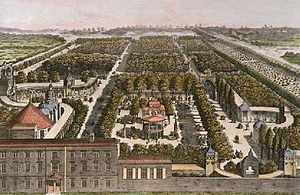From the mid 17th century to the mid 19th century, Vauxhall Gardens was London’s premier entertainment centers. Situated by the Thames, the cheap admission and accessibility by a burgeoning middle class made Vauxhall a hot spot during the Regency era.
Orchestras played, fireworks often sounded, and light refreshments and cold suppers were served. Most famous on the menu was the ham “as thin as muslin” which people could enjoy in supper alcoves dressed with contemporary paintings like those of Hogarth. Fountains and walkways were illuminated with colorful lights, and the famous cascade turned on at 9:00 in the evening to the amusement of many. Hist-ro’s often utilize the walkways as a place for trysts, as the garden paths were many and some more dimly lit (perfect for discreet lip-lock).
After the construction of the Westminster Bridge in the 1750s, Vauxhall could be reached by road, but most still preferred to arrive on boats chartered from Westminster or Whitehall. By the 1816 construction of the Vauxhall Bridge, access by land was more common although visitors still enjoyed reaching the venue by boat due to the romance and spectacle of the water side entrance.
The London pleasure gardens of the eighteenth century, 1896
Here is a wonderful excerpt from an article written by Charles Dickens on Vauxhall, “We loved to wander among these illuminated groves, thinking of the patient and laborious researches which had been carried on there during the day, and witnessing their results in the suppers which were served up beneath the light of lamps and to the sound of music at night. The temples and saloons and cosmoramas and fountains glittered and sparkled before our eyes; the beauty of the lady singers and the elegant deportment of the gentlemen, captivated our hearts; a few hundred thousand of additional lamps dazzled our senses; a bowl or two of punch bewildered our brains; and we were happy.”
For more on Vauxhall Gardens, check out this great resource.
Lesser known (at least within the tomes of hist-ro) is Ranelagh Gardens were at the Ranelagh House in Chelsea, built by the first Earl of Ranelagh in 1688. The Earl died in 1712, and a length proceeding including an act of Parliament was needed to vest his property. In 1741, Ranelagh’s house and grounds were purchased by a group headed by owner of the Theatere Royal and subsequently opened to the public. Considered more fashionable than Vauxhall, entrance was two shillings sixpence compared with less expensive entrance at Vauxhall (one shilling). Ranelagh was influential, introducing the masquerade to the new middle class.
Like Vauxhall, Ranelagh was in the Rocco style, and featured a rotunda and a Chinese pavillion (called the Chinese House) as well as several walks and a lake. More than Vauxhall, it had a reputation for being a convenient and popular place for courtship and romantic assignations.
Ranelagh also featured a circle of boxes in the rotunda interior (separated by wainscoting) and decorated with paintings and a candle lamp. Above these bozes another tier of boxes (52) could seat seven to eight people and were lit by a circle of sixty windows. The center was discovered to be poor placement for the orchestra, and so was transformed before its public opening into four fireplaces where one could warm themselves during chillier nights.
Unfortunately, the rotunda came down around 1803 before the Regency era but the pleasure grounds still exist.












For a list of musicians, singers and players who appeared at Vauxhall between 1661-1859, go to
http://www.vauxhallgardens.com/index.html
I have other wonderful links like this listed on my website at:
http://www.joannawaugh.com
For me, an art historian, to come across pleasure gardens via literary sources may seem strange, but it goes to show that history is written from a wide ranges of sources. In particular I liked Dr Samuel Johnson, and his party.
Thanks for the link
Hels
Art and Architecture, mainly